

Growers should send a 500g seed sample to DPIRD Diagnostic Laboratory Services to establish the level of PSbMV infection before sowing.
Sending samples for testing is easy. Just drop your sample into one of our pre-printed despatch bags, available on request, or address your sample to our reply paid address:
DDLS Seed Testing and Certification
Department of Primary Industries and Regional Development
Reply Paid 83377
3 Baron-Hay Court
South Perth WA 6151
Contact information
DDLS Seed Testing and Certification
Phone: +61 (0)8 9368 3721 or email: DDLS Seed Testing and Certification.
Each season, growers can be reminded to get seed tested, assess their PSbMV risk and make informed management decisions using the free SMS PSbMV risk alert service, which is available for the locations below. This risk alert service will complement the existing blackspot risk alert.
If you would like to subscribe to this service please text ‘pea virus’ to +61 (0)475 959 932 with your name and closest weather station or your locality.
Management
As well as sowing healthy seed, an integrated management approach is vital to reducing losses since insecticides are ineffective for PSbMV control.
- Target early canopy development. Early seeding at high rates (more than 120kg/ha) and narrow row spacing (18cm) will promote an early, dense plant canopy before aphid arrival. This will help shade out the seed-infected plants that act as a source of PSbMV infection and also reduce aphid landings.
- Retaining stubble helps decrease early virus spread by reducing aphid landing rates while bare earth between plants attracts incoming migrant aphids.
- Avoid potential virus sources by isolating pea crops from other pulse or field pea crops sown with untested seed stocks as these could be a potential source of PSbMV.
- Cultivar choice. If healthy seed of the agronomically best cultivar is not available, use PSbMV-resistant Wharton.

